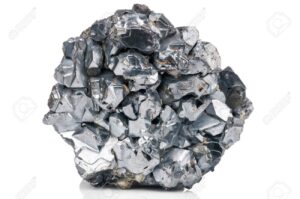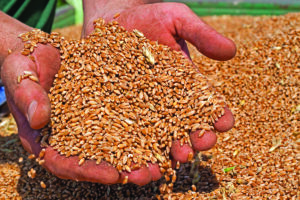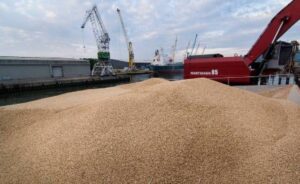
Ukraine in January-April this year reduced the export of titanium-bearing ores and concentrate by 43.7% compared to the same period last year, to 129,212 tonnes.
According to statistics released by the State Customs Service (STS), in monetary terms, the export of titanium-bearing ores and concentrate decreased 18.6%, to $47.247 million.
At the same time, major exports were to the Czech Republic (50.79% of supplies in monetary terms), the United States (18.45%) and China (7.98%).
Ukraine in January-April 2022 imported 100 tonnes of similar products from Senegal for $138,000, while in January-April 2021 it imported 180 tonnes from Senegal for $160,000.
As reported, Ukraine increased the export of titanium-bearing ores and concentrate in kind by 3% in 2021 compared to 2020, to 553,051 tonnes. In monetary terms, the export of titanium-bearing ores and concentrate grew by 17%, to $161.914 million. Majot exports were to Mexico (21.23% of supplies in monetary terms), China (18.17%) and the Czech Republic (14.07%).
In 2021, Ukraine imported 1,172 tonnes of titanium-containing ores worth $1.227 million from Senegal (87.03%) and Germany (12.97%), while in 2020 it imported 1,010 tonnes worth $855,000.
In Ukraine, at present, titanium-bearing ores are mined mainly in the PJSC United Mining and Chemical Company (UMCC), under whose management the Vilnohirsk Mining and Metallurgical Plant (Dnipropetrovsk region) and Irshansk Mining and Processing Plant (Zhytomyr region) were transferred, as well as Mezhdurechensk Mining and Concentration Complex LLC and Valki-Ilmenite LLC (both LLC are located in Irshansk, Zhytomyr region).
In addition, the production and commercial company Velta (Dnipro) built a mining and concentration complex at the Birzulivske deposit with a capacity of 240,000 tonnes of ilmenite concentrate per year.
Holding company Velta Group Global Ltd. registered in London in November 2011.

Ukraine in January-April this year reduced the export of cast iron by 52.7% compared to the same period last year, to 451,142 tonnes.
According to statistics released by the State Customs Service (SCS), over the specified period, the export of cast iron in monetary terms decreased 50.4%, to $220.179 million.
At the same time, exports were carried out mainly to the United States (52.42% of deliveries in monetary terms), Turkey (18.58%) and Italy (17.59%).
In January-April 2022, Ukraine imported 15 tonnes of cast iron from Germany for $25,000, while in the first four months of 2021 it imported 46 tonnes of cast iron for $49,000 from Germany (76%) and Slovakia (24%).
As reported, Ukraine in 2021 increased the export of cast iron by 4.2% compared to 2020, to 3.236 million tonnes, the export of cast iron in monetary terms grew by 78.1%, to $1.643 billion. At the same time, exports were carried out mainly to the United States (53.61% of deliveries in monetary terms), Italy (22.08%) and Turkey (9.74%).
In 2021, Ukraine imported 185 tonnes of pig iron worth $226,000 from Germany (74.34%), the Russian Federation (20.35%) and Slovakia (5.31%), while in 2020 it imported 593 tonnes worth $417,000.

For the period from May 1 through May 19, 2022, Ukraine exported 643,000 tonnes of grain crops, while the export rate increased: for the week from May 12 to May 19, 344,000 tonnes were delivered to foreign markets, while for a week and a half of this month (from May 1 through May 12) this figure amounted to 299,000 tonnes.
However, as reported on the website of the Ministry of Agrarian Policy and Food on Thursday, the rate of grain exports since the beginning of May this year is 2.8 times lower compared to the same period last year (1.8 million tonnes were exported from May 1 to May 19, 2021).
Such a decline in the ministry is explained by the blockade of Ukrainian seaports, a key export infrastructure, by the troops of the aggressor country of the Russian Federation.
According to the Ministry of Agrarian Policy, since the beginning of 2021/22 (July-June) and as of May 19, the country has exported 46.51 million tonnes of grain and leguminous crops, which is 13.8% higher than the figures for the same date of the previous year. This excess of last year’s indicators is caused by a record harvest in the current year and the high intensity of its export before the Russian invasion on February 24.
In total, from the beginning of 2021/22 as of May 19, 2022, Ukraine had exported 18.54 million tonnes of wheat (18.7% more compared to the same date in 2020/21), 21.83 million tonnes of corn (6.9% more), 5.68 million tonnes of barley (37.2% more), 70,600 tonnes of flour (35.7% less).
For the period from May 12 to May 19, 333,000 tonnes of corn, 10,000 tonnes of wheat and 600 tonnes of flour were exported. Barley and rye were not exported during the specified period. In total, since the beginning of May, 617,000 tonnes of corn, 16,000 tonnes of wheat, 8,000 tonnes of barley and 1,100 tonnes of flour have been exported.
If to compare the current data of the agro-industrial complex portal with its indicators as of February 21, the last update before the Russian military invasion of Ukraine, it could be established that during the war Ukraine exported 3.97 million tonnes of grain and leguminous crops, of which 3.14 million tonnes of corn, 690,000 million tonnes of wheat, 110,000 tonnes of barley and 4,000 tonnes of flour.

Prime Minister Denys Shmyhal says that Ukraine is not only significantly expanding its export opportunities, but also continues to integrate as much as possible into European projects.
“We are not only significantly expanding our export opportunities, but also continuing to integrate as much as possible into European projects. This is very important on the way to our full membership in the EU,” Shmyhal said at a government meeting on Friday.
The prime minister said that on May 12, the European Commission announced the creation of “Solidarity Lanes,” a route that would speed up exports and the work of customs between Ukraine and the EU.
“In order to speed up logistics, the European Commission will also create a special platform for simplified border crossings across the solidarity lanes and encourage EU market participants to provide additional trucks and other transportation capacities,” he said.
In addition, Shmyhal said the European Commission had already decided to conclude an agreement with Ukraine and update the map of the Trans-European Transport Network (TEN-T).

The export of Ukrainian agricultural products through the EU countries, including taking into account deliveries through the Danube river ports, cannot exceed 1.5 million tons per month under any circumstances, while before the blockade of its seaports by the Russian troops, the country could transship more than 5 million tons per month. million tons of agricultural crops per month.
The opinion about the need for Ukraine to work on the launch of new logistics routes and export directions was expressed by First Deputy Minister of Agrarian Policy and Food Taras Vysotsky during the expert discussion “Blocked trade: can Ukraine increase export capacity” on Friday.
“We preliminary calculated that up to one and a half million tons is still the maximum. Therefore, I think that we can count on this until May, and then only alternative directions,” Vysotsky said.
He clarified that Ukraine has enough agricultural products for export, and Ukrainian farmers can supply as much grain as they need to foreign markets, and the volume of its exports is limited only by logistics.
As reported with reference to the Minister of Agrarian Policy Mykola Solsky, in April 2022 Ukraine exported 1.09 million tons of grain mainly through Romanian ports, which is more than five times higher than in March.
According to him, most of the export deliveries from Ukraine were carried out in April through the river ports of the Danube, since the Ukrainian Black Sea ports are blocked by Russian warships.
At the same time, the logistics of Ukrainian agricultural products through Romania may become more complicated and slow down in June, when a new crop of Romanian, Serbian, Hungarian and Bulgarian winter wheat and barley will begin to arrive at the seaports of this country and will create competition with supplies from Ukraine.

The export of Ukrainian agricultural products through the EU countries, taking into account deliveries through the Danube river ports, cannot exceed 1.5 million tonnes per month under any circumstances, while before the blockade of its seaports by the Russian troops, the country could monthly transship over 5 million tonnes of agricultural crops per month.
An opinion about a need for Ukraine to work on the launch of new logistics routes and export directions was expressed by First Deputy Minister of Agrarian Policy and Food Taras Vysotsky during the expert discussion “Blocked trade: can Ukraine increase export capacity” on Friday.
“We preliminary calculated that up to 1.5 million tonnes are still the maximum. Therefore, I think that we can count on this until May, and then only alternative directions,” Vysotsky said.
He clarified that Ukraine has enough agricultural products for export, and Ukrainian farmers can supply as much grain as they need to foreign markets, and the volume of its exports is limited only by logistics.
As reported with reference to Minister of Agrarian Policy Mykola Solsky, in April 2022 Ukraine exported 1.09 million tonnes of grain mainly through Romanian ports, which is more than five times higher than in March.
According to him, most of the export deliveries from Ukraine were carried out in April through the Danube river ports, since the Ukrainian Black Sea ports are blocked by Russian warships.
At the same time, the logistics of Ukrainian agricultural products through Romania may become more complicated and slow down in June, when a new crop of Romanian, Serbian, Hungarian and Bulgarian winter wheat and barley will begin to arrive at the seaports of this country and will create competition with supplies from Ukraine.